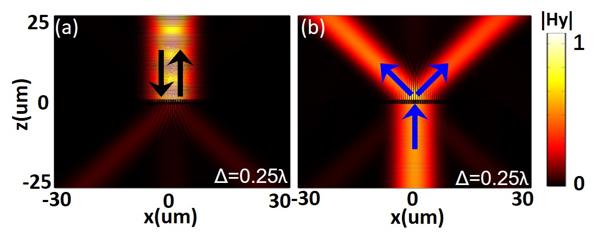The asymmetric transmission of electromagnetic waves refers to the difference in transmittance or polarization state when they pass through media from two opposite directions. This asymmetric transmission effect has potential applications in the integrated photonic system of optical communication, information processing and all-optical computing, and has been one of the important research topics. The traditional devices with asymmetric response are too bulky to meet the needs of the integration and miniaturization of modern optical devices. In recent years, much effort has been devoted to metasurfaces used to the design of asymmetric transmission devices. Due to its flat and ultra-thin features, metasurfaces have unique application prospects in miniaturized and integrated devices compared with traditional optical components.
At present, most of metasurface-based asymmetric transmission devices work in the low-frequency regime, such as the terahertz band. There are few studies on asymmetric transmission in visible light. Although some studies have proposed conically structured optical metasurfaces that can achieve asymmetric transmission and have good broadband response, but their asymmetric response is weak. Therefore, how to design a high-efficiency asymmetric transmission device with a simple structure is still an open problem to be solved urgently.
Recently, the Prof. Yadong Xu's group from Soochow University proposed a device based on bi-layer meta-gratings that can enable efficiently beam splitting and asymmetric transmission, with obtained results published in Chinese Optics Letters Volume 19, Issue 4 (Shi Qiangshi, et al, Optical beam splitting and asymmetric transmission in bi-layer metagratings).

Magnetic field diagram of asymmetric transmission
A bi-layer meta-grating with an operating wavelength at near 650 nm is designed and studied. The designed metagrating is relatively simple, with each period containing only two unit cells. They showed that the interlayer interaction can be controlled by changing the layer gap of the bi-layer meta-grating, which can lead to a transition from nearly perfect beam splitting to high-efficiency asymmetric transmission. Specifically, when the gap size is zero, the normally incident light from both sides will almost perfectly transmit through the bi-layer meta-grating, generating spatial beam splitting. When the gap size meets certain values (i.e., ), for positive normal incidence (PI), the transmission is about 2%, while for negative normal incidence (NI), the transmission is about 92.5%.
The researchers also made an optimization by considering the real material parameters, which further revealed the good asymmetric transmission effect and verified the feasibility of the bi-layer metagrating in experiment. This work provides a way for the design of high-efficiency asymmetric transmission devices and multifunctional devices in the visible light.


